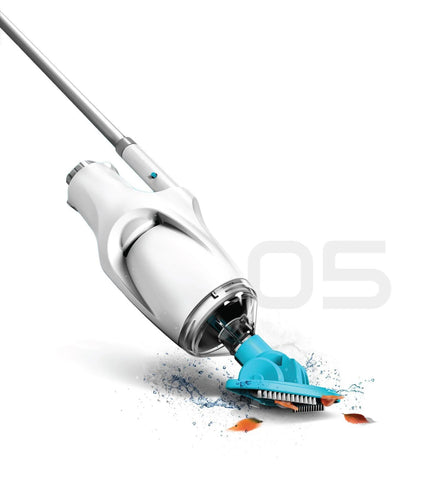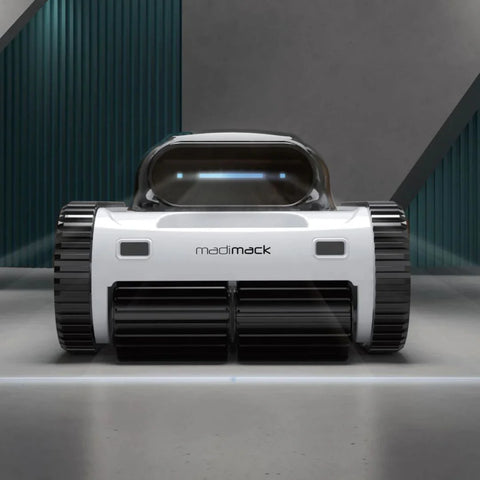What Is the Best Pool Vacuum Cleaner Type for Your Pool?

When it comes to maintaining a pristine swimming pool, choosing the best pool vacuum cleaner is paramount. However, as there is a myriad of options available, selecting the right one can seem daunting. Each pool vacuum type offers unique features tailored to different needs and preferences.
On the positive side, whether you prioritise affordability, convenience, or cleaning effectiveness, there's a pool vacuum perfect for you. You just need to know how to find it. So let's explore the different types of vacuum pool cleaners to help you make an informed decision.
The 2 Types of ‘Vacuum’ Pool Cleaners
When you are choosing the best pool vacuum for your needs, before you start searching for a specific model or brand, you should decide on the type you want because they all have different advantages and disadvantages. Even more importantly, it is important to understand the difference between a true manual vacuum and an automatic pool cleaner.
The issue is that automatic pool cleaners are often called and marketed as pool vacuums, so it’s only natural that people assume that they are simply a type of pool vacuum and do a similar job to manual vacuums. However, manual pool vacuums and automatic pool cleaners are not the same type of device and don’t serve the same purpose.
In short, manual vacuums are designed for vacuuming larger debris, such as after you’ve added flocculant to your pool and let the debris settle, where everything that’s vacuumed is collected and thrown out when you are done, without entering your filtration system.
On the other hand, automatic pool cleaners are designed for regular maintenance by automatically cleaning your pool and vacuuming smaller debris by utilising the pool’s filtration system (except robotic vacuum cleaners, but we will explain how they are unique later in the article).
To properly clean your pool, you will likely want both a manual vacuum and a pool cleaner. However, there are also subtypes of these devices that have specific pros and cons - 2 subtypes of manual vacuums and 3 subtypes of automatic pool cleaners. So let’s discuss the two main types and their subtypes.
Manual Vacuum Cleaners
Manual vacuums are a wallet-friendly and straightforward solution for pool cleaning. They resemble traditional vacuum cleaners and function much the same way. These devices are equipped with a vacuum head attached to a telescoping pole and come in two types.
The first type connects to the skimmer plate via a hose and utilises the filter suction for vacuuming. During vacuuming, the filter setting needs to be set to waste so that all of the water goes to sewage and does not enter the filtration system. This type of manual vacuum is more affordable than the second type, however, it has one significant drawback - it can typically only be used for pools that have sand filters.
Sand filters have a valve that lets you release the water to sewage, while cartridge filters typically don’t have this option. For a pool with a cartridge filter, you need the second type - a battery-powered vacuum. These vacuums are not connected to the pool's filtration system and collect debris in their own filter that you empty out once you are done vacuuming. This type is typically more expensive than the first one.
So, when choosing the best pool vacuum for your pool, you need to think about what type of filter you have. If your pool has a sand filter and you are looking to save some money, you can get a vacuum that connects to the skimmer plate. If your pool has a cartridge filter or you are simply looking for a more versatile option, you should get a battery-powered vacuum.
We should also give a quick tip about pool vacuuming here - regardless of what vacuum you are using, hastening the cleaning process is not advised, as rapid movements can stir up debris, reducing suction effectiveness, and causing cloudiness in the water. You should opt for a slow, deliberate approach that minimises disturbance and ensures thorough cleaning.
Automatic Pool Cleaners
Unlike manual vacuums, automatic pool cleaners are not designed to vacuum large pieces of debris. Often, they will end up pushing them around on the pool floor instead of sucking them up. Automatic cleaners are intended for regular maintenance to prevent the build-up of smaller particles, algae, etc., that cause the water to become cloudy and to minimise how often you need to use a manual vacuum or chemicals. They come in three types:
1. Suction-Side Pool Cleaners

Suction-side pool vacuums utilise the suction power generated by your pool's circulation system to remove debris. They are usually connected to a suction port or the skimmer and roam around the pool, actively vacuuming up any debris they encounter. Many are also equipped with scrubbing brushes to clean sticky debris or algae.
Usually, suction-side cleaners are more expensive than manual vacuums and cheaper upfront compared to standalone robotic cleaners, however, they consume more electricity due to their reliance on the pool's pump and filter system. While the vacuuming process is automated, they rely on your pool's pump, so maintenance tasks such as backwashing and emptying the filter, as well as clearing any obstructions from the skimmer, are necessary after each use.
These vacuum cleaners may also take longer to complete a thorough cleaning cycle than some other types. Moreover, since they rely on the pool's filter system, they contribute to increased wear and tear, potentially requiring more frequent replacements. It's essential to factor in these additional maintenance considerations when evaluating whether this is the best pool vacuum cleaner type for you.
Pros:
- Cost-effective compared to robotic alternatives
- Utilises existing pool pump and filter system
- Effective in capturing debris from the pool surface and bottom
- Scrub your pool’s floor and walls
Cons:
- Higher electricity consumption than standalone robots
- Longer cleaning cycles
- Contributes to increased wear and tear on the pool's filter system
2. Pressure-Side Pool Vacuums

Similar to suction-side cleaners, pressure-side pool vacuum cleaners utilise your pool's pump and filter system for operation. However, what makes them different is that they harness pressurised water expelled from the pump rather than relying on suction.
This pressurised water is directed through the cleaner, creating a powerful suction that lifts debris from the pool surface and bottom. Unlike suction-side cleaners, which draw debris into the pool's filter, pressure-side cleaners typically feature their own canisters or filter bags (this feature is similar to manual battery-powered vacuums).
These components are more economical to replace compared to the primary filter in the pool's pump. Additionally, since debris is not directed through the pool's filter, there's no need for backwashing after each use, although cleaning the filter bag is still necessary. The best pressure-side vacuums also have in-built brushes that do a decent job of scrubbing your floor and walls.
While pressure-side cleaners tend to be pricier upfront compared to suction-side options, the potential savings on filter replacements may offset this initial cost difference over time. However, it's important to consider the ongoing expenses associated with maintaining and replacing filter bags, as well as the additional electricity consumption resulting from their reliance on the pool's pump.
Pros:
- Utilises pressurised water for efficient cleaning
- Separate canisters or filter bags reduce strain on the pool's primary filter
- Eliminates the need for backwashing the pool's filter after each use
Cons:
- Higher electricity consumption due to reliance on the pool's pump
- The initial investment may be higher than suction-side cleaners
- Ongoing expenses for filter bag replacements should be considered
3. Robotic Vacuums

Finally, we get to the most advanced piece of pool cleaning equipment - robotic vacuum cleaners. They epitomise convenience for pool owners, albeit at a premium price point. You need to invest minimal effort and they will efficiently clean your pool in most cases. Simply program a cleaning cycle and let the cleaner do the work.
Robotic vacuums are equipped with their own filter bag or capture canister and these need to be emptied after each use. Unlike suction-side and pressure-side cleaners, robotic pool cleaners operate independently of your pool's filter or pump. They operate either on battery power or can be conveniently plugged into the nearest socket via a sufficiently long extension cord.
This autonomy results in significantly lower maintenance costs over time, including reduced expenses for replacement filters and lower power consumption. In fact, it's recommended to avoid running your pool's pump while the robotic cleaner is in operation to prevent debris from being dispersed away from its suction. A robotic cleaner is the best pool vacuum if you aim to invest as little time as possible into cleaning your pool.
However, while robotic pool cleaners excel in routine maintenance, like all automatic cleaners they have one major drawback - vacuuming larger debris. Even items as small as an acorn can impede their performance, potentially blocking suction or being left behind as the device prioritises smaller debris. Thus, it’s recommended to at least use a net to fish out large chucks before you set a robotic cleaner to work.
Pros:
- Convenience and ease of use
- Efficient cleaning with minimal effort required
- Operates independently of pool's filter and pump, reducing maintenance costs and power usage
Cons:
- Higher initial cost compared to other types of pool cleaners
- Limited effectiveness with larger debris
- Potential for blockages or inefficiencies with certain types of debris
How To Choose the Best Pool Vacuum Cleaner
When selecting the best pool vacuum cleaner for your needs, several factors should be considered. First, assess your budget and determine how much you are willing to invest in pool maintenance. For a pristine pool, you’ll want both a manual vacuum and an automatic cleaner. In case you can only choose one, then a manual vacuum is probably the better option as you will at least cover the basics.
Also, think about your pool’s primary filter - is it a sand or cartridge filter? This can determine the type of manual vacuum you need. When it comes to automatic cleaners, consider the size and type of your pool, as well as the frequency of use, to gauge the level of cleaning required - each type operates differently and has specific advantages and disadvantages.
Robotic cleaners excel in routine maintenance but they cost more upfront, while suction-side and pressure-side cleaners are more affordable but rely on your pool’s pump system to function, increasing operative costs. Factor in ongoing maintenance costs, such as filter replacements and wear and tear, to determine the long-term affordability of each option.
Where Can You Get the Best Pool Vacuum?
If you know what the best pool vacuum type is for you, we can help you get one. At Direct Pool Supplies, we have everything you need for your pool, from manual vacuums to all types of pool cleaners, from suction-side and pressure-side cleaners to robotic pool cleaners.
You can place your order online and we will deliver it directly to your address. If you have questions about a specific product or wish to know more about our shipping, warranty, or any other policy, don’t hesitate to contact us! We will gladly answer any questions you have.